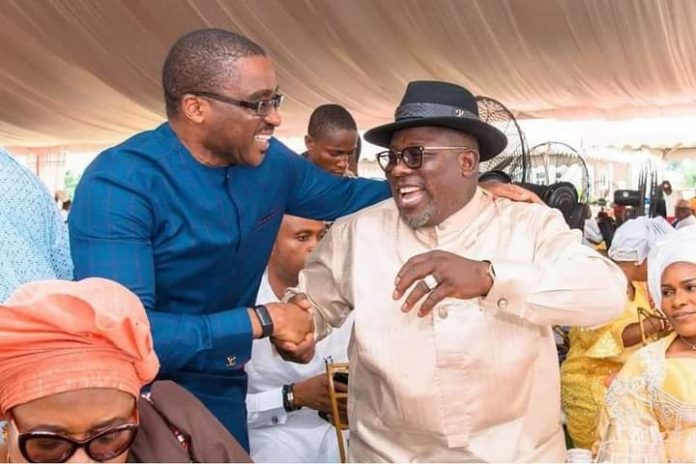A forensic report conducted by Apex Forensic Nigeria Limited has been widely circulated on social media. The report is the latest in a series of publicity stunts aimed at discrediting the candidature and good reputation of the Rt. Honourable Speaker of the Delta State House of Assembly, Sheriff Francis Orhowedor Oborevwori.
Opponents of Oborevwori would like to con his supporters and unsuspecting members of the public into believing unfounded allegations of identity theft. However, a closer examination of the report exposes it as an unreliable document prepared by a “hired gun”. It is neither independent nor credible and should be disregarded in its entirety. We draw the attention of independent thinking members of the public to the following.
Equipment:
Any IT hardware and software used for the viewing, processing, and analysing of imagery for a Facial Image Comparison must be fit for purpose and validated for its intended use. At the barest minimum, this validation should state if the process results in any visual loss of quality to the displayed or outputted imagery and if this loss impacts the subsequent examination and comparison. It is this information that gives the process credibility.
The report states that the analyst used a QDX630B Spectral Comparator and Highly Illuminating F OX VM Multimedia Computers and other Scientific Apparatus. Therefore, we urge members of the public to do a simple internet search to research the use of the listed equipment.
Firstly, a Spectral Comparator is not intended to be used for a Facial Image Comparison. Instead, it is used to detect imperfections in documents. It does so by using electromagnetic wavelengths and various filters to differentiate inks and reveal hidden material on documents.
Secondly, the term “Highly Illuminating F OX VM Multimedia Computer” is meaningless without specifying the hardware and software used in the apparent “forensic analysis”.
Thirdly, what other “Scientific Apparatus” did the examiner used? He did not specify it because he has not deployed any specifically designed equipment for a facial image comparison. The whole exercise is arbitrary and a sham. It is designed not to project the truth but to embarrass a candidate that the opposition fears and to deceive members of the public.
Examiner’s expertise:
The examiner, Chief Reginald Udunze, describes himself as a forensic document examiner/handwriting expert. While he may be accomplished in his field of training, there is a vast difference between a forensic document examiner and a facial image comparison expert.
The examination of documents includes detecting alterations and obliterations, analysis of paper, detection and examination of forgery, origin, determining authenticity, and others. Members of the public should note that the examiner, Chief Udunze, does not say that any documents he examined were forged. However, with the greatest respect, Chief Udunze’s qualification as a forensic document examiner does not make him a facial image comparison expert.
Facial image comparison experts compare images of unfamiliar faces (i.e., faces not known to them) and decide whether or not they show the same person. Given the importance of these decisions for national security and criminal investigations, practitioners attend training courses to improve their face identification ability.
Questionable technique:
The “forensic examination” starts on the incorrect premise by presuming that the reference imagery was each taken at the same time, at the same angle and distance and of the same image quality. These factors can significantly affect the comparison.
The examiner did not use original photographs, but images submitted by Oborevwori’s opponents. He did not analyse whether these images were altered in any way.
Additionally, a significant amount of time elapsed between the photographs in question. The first was taken in about 1999. The second photograph was taken 15 years later, in about 2014. Finally, the third photograph was taken in about 2018, 4 years after the second photograph and 19 years after the first photograph.
As individuals grow and age, facial features can change significantly. The examiner does not account for this factor. The following are common features of adult ageing:
Hair loss and changes in hair pigmentation
Sagging of soft tissue Increased number and depth of facial lines at areas of repeated muscle use and facial fat pad junctures
Density of fatty tissue under and descent of facial fat pads
A significant amount of time between the images can limit the use of a facial image comparison. The examiner’s current conclusions are unreliable as facial features change naturally with age. Therefore, the examiner should have (but failed to) call for additional imagery within a closer age range.
Also, the first image submitted to the examiner was of significantly low quality, resulting in limited or, at worst, unreliable findings. The examiner did not perform an image quality analysis on any of the submitted photographs to determine:
Pixel resolution of the face as determined by the overall resolution of the image and the distance of the subject from the camera
The lighting conditions of the image and the impact this has on the visibility of features and the degree of contrast between different features
Blur within the image causing a potentially irrecoverable loss of detail
Geometric distortions such as lens barrelling that may distort the appearance of facial features
If the angle of the camera is causing occlusion of facial features
If other factors such as clothing or physical obstruction are occluding facial features
No independent verification of the exercise:
The fallout from the Delta State Governorship primary elections has been the subject of intense media scrutiny. For this reason, the examiner should not be exposed to imagery before conducting their comparison to minimise possible sources of bias, such as confirmation bias. This is why independent verification is key and accords with international best practices.
A second independent examiner should repeat the entire facial image comparison process to verify the result. There should have been a blind verification by the second examiner without knowing the conclusion of the first examiner. This prevents confirmation bias and preserves the integrity of the process.
There was absolutely no verification in this case.
For the avoidance of doubt, Sheriff Francis Orhowedor Oborevwori has never submitted any false documents as alleged or at all. He has not stolen any person’s identity as alleged or at all – indeed, none of Oborevwori has brought forward the person they identify as the genuine holder of the identity. The reason for this failure is simple. All the photographs shown in the examination are of Sheriff Francis Orhowedor Oborevwori.
It is curious that a document apparently addressed to the Deputy Commissioner of Police, Guzape District FCT Abuja, has found its way to WhatsApp and Facebook, instead of the intended recipient.
Equally curious is how a complaint of events allegedly occurring in Delta State has found its way to Guzape District FCT Abuja. Opponents of Sheriff Francis Orhowedor Oborevwori should test their popularity at the polling booth, not on social media pages.
Remain Sheriffied.
Expect M.O.R E from 2023 to 2031.


